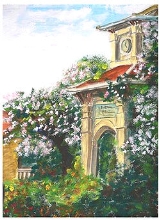
Le Hong Phong High School
Encyclopedia
Le Hong Phong High School for the Gifted (Petrus Ky High School) is a high school
in Ho Chi Minh City
, Vietnam
. Established in 1927, the school is one of the oldest high schools still operating in Vietnam. The school is specialized for gifted students who show their exceptional talents in academic fields such as basic sciences, social science and languages. The aim of Le Hong Phong High School for the Gifted is to give its students the best conditions to achieve excellence in life.
). In 1925, The architect Hebrard de Villeneuve was commissioned to design a school in Chợ Quán. On November 28, 1927, a temporary branch of Collège Chasseloup-Laubat, called Collège de Cochinchine, was founded in Chợ Quán for native students. The branch was under the management of the Board at Collège Chasseloup-Laubat.
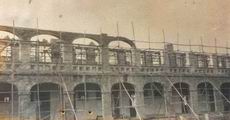
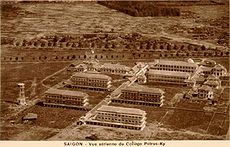
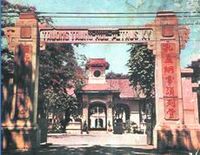 The construction of the school was completed in 1928. On August 11, 1928, the interim Governor-General of French Indochina
The construction of the school was completed in 1928. On August 11, 1928, the interim Governor-General of French Indochina
, René Robert, signed Decree no. 3116 to establish a native French secondary school (Lycée), combining Collège de Cochinchine and about 200 pupils from Collège Chasseloup Laubat. The Governor Blanchard de la Brosse named the school Lycée Petrus Trương Vĩnh Ký
after the Vietnamese Catholic who served the French colonial government. Therefore the school was known as Petrus Ky High School, and this name was used for nearly 50 years.
In 1941, the school was temporarily relocated to the Pedagogical College of Saigon due to the war. It resumed its regular teaching activities in the same year, at its own establishment. In 1945, the school was temporarily closed after evacuating to Tan Dinh
district. It re-opened in April 1946 in a seminary on Lucien Mossard street. It returned to Cho Quan in 1947.
In 1961, it became a secondary school
in the Southern Vietnamese educational system. In 1976, the school was renamed after a former general secretary of the Communist Party of Vietnam
, Le Hong Phong, and became a high school
. In 1990, it was made a high school for the gifted students. Its current name is Le Hong Phong High School for the Gifted. Unlike most other high schools in Vietnam, the school admits its students by entrance examinations..
to 12th
. Le Hong Phong High School for the Gifted conducts entrance examinations for admission. Its long-standing prestige as the foremost high school in the area attracts many applicants and the competition is fierce. Student must sit four exam papers in Mathematics, Literature, Foreign Language (English) and a paper on one of the eleven subjects offered in the classes for majors. Students applying to the bilingual Vietnamese-French programme are admitted on a different panel. In the 2006/2007 academic year, the school admitted 250 students into 12 classes for majors and 400 students into 8 classes for non-majors.
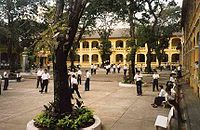 The school offers 12 classes for majors, each specialising in a single subject including: Mathematics
The school offers 12 classes for majors, each specialising in a single subject including: Mathematics
, Physics
, Computer Science
, Chemistry
, Biology
, Geology
, History
, Literature
, English
, French
, Russian
and Chinese
. Students in these classes do not have to pay tuition fees.
Upon applying to Le Hong Phong, applicants must specify the section in which to study. A section is a study programme in which the student chooses to specialise in three out of the eleven mandatory subjects. The entrance examination papers for each section differ in level of difficulty of each subject.
Students in the classes for non-majors are subjected to a small tuition fees.
The bilingual French - Vietnamese programme is taught in both Vietnamese and French. At the end of 12th grade, students attend two examinations: the Vietnamese National Baccalaureate
and the Bilingual Baccalaureate recognised by the Francophone
community.
The prominent student organisation at Le Hong Phong is the Youth Division of the Communist Party of Vietnam
. The organisation organises annual recreational and charity events, many of which have become Le Hong Phong traditions.
Amongst the best-known alumni are the political leaders Trần Văn Ơn, Nguyễn Thái Bình, Dương Minh Châu, Huỳnh Văn Kiểng. Huỳnh Tấn Phát, Truong Tan Sang; composer Lưu Hữu Phước, professors Nguyễn Văn Chì, Trần Văn Khê, Trần Đại Nghĩa,, Trịnh Kim Ảnh, Nguyễn Ngọc Trân. Notably, Nguyen Minh Triet, the outgoing President of Vietnam
, and incoming President Trương Tấn Sang
, also attended the school. In popular culture, singers Cẩm Ly, Đức Tuấn,Hà Anh Tuấn and Tóc Tiên are also Le Hong Phong graduates.
Almost 100% of its students pass the National Baccalaureate examination and more than 90% gain entrance to universities and colleges. It is a strong contestant in the national and international student academic competitions. In the school year 2006-2007, 291 students from Le Hong Phong won the City student academic aptitude competition in 12 subjects and 23 students won the National competitions. It is one of the 2 most well-known high schools in Ho Chi Minh city, together with High school for the Gifted (Nang Khieu high school).
Within a year, the club and its activities were prohibited by the French-Indochina government. In 1942, Petrus Ký students, inspired by students in Hanoi
, founded an organisation named S.E.T (Section Exécution Tourisme). The organisation functioned as a scout programme aiming at developing character, citizenship, and personal fitness qualities. During this time, several Petrus Ký professors such as Phạm Thiều, Lê Văn Chí and Trần Văn Thanh, also subtly professed their patriotism in lectures.
As France re-occupied Vietnam, in 1948, Petrus Ký students were the leaders in the movement "Teach and Learn in Vietnamese". On September 10, 1949, the first day of the academic year, students of several schools together with scholars and parents went on strike for a month to demand the Minister of Education of these issues. The government closed Petrus Ký and Gia Long and imprisoned a number of students. The students continued to be on strike and demanded immediate release of the imprisoned students.
On January 9, 1950, over 2000 students from Petrus Ký, Gia Long, Áo tím, Kỹ Thuật... protested in front of the Ministry of Education and then the Governor Palace. The government tried to disperse the crowd; however, the number of protesters had risen to more than 50,000 people. The police started firing into the crowd and Tran Van On, a student from Petrus Ký, was killed.
On January 12, 1950, the city went on strike to attend Tran Van On's funeral. Students from Mỹ Tho, Cần Thơ, Huế
, and Hanoi
came to Sai Gon to participate in the ceremony, carrying protesting banners. More than 1 million people were at the funeral. This was the largest funeral in Sai Gon since the funeral of Phan Chu Trinh
in 1925.
On July 14, 1954, Petrus Ký student started the movement to demand independence and democracy at the school by drawing slogans on walls and blackboards, openly supporting the Geneva Accord
.
On March 30, 1955, conflicts between the national army and Binh Xuyen
arms broke out. Binh Xuyen's volunteering force stationed at Petrus Ký. On April 30, 1955, the national army fought Binh Xuyen out of the school and other locations. On May 1, 1995, Petrus Ký students form a committee to help victims of the conflict. The committee was able to gather considerable amount of money and aids for the people.
In 1970, Petrus Ký students organised a strike and a take-over of the Cambodian Embassy to protest against Lon Nol
's massacre of Vietnamese expats living in Cambodia
.
In 1972, Nguyen Thai Binh, a Petrus Ký alumnus
studying in the United States, participated in anti-war demonstrations and wrote a letter to President Richard Nixon
condemning crimes against the Vietnamese people. He was deported from the United States and returning to Vietnam
, attempted to hijack the Pan American 747 as it approached Saigon. He was shot dead by a vacationing American police officer.
On April 30, 1975, the South Vietnam Liberation Force, headed by General Tran Van Tra
, was stationed at the school. The school was temporarily closed until July 1975 and the class of 1974-1974 took their final examinations and graduated in September 1975.

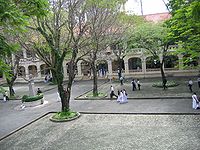
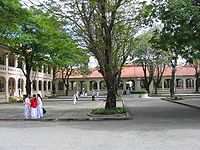
|width="50px" |
|valign=“top”|
|width="50px" |
|valign=“top”|
|}
High school
High school is a term used in parts of the English speaking world to describe institutions which provide all or part of secondary education. The term is often incorporated into the name of such institutions....
in Ho Chi Minh City
Ho Chi Minh City
Ho Chi Minh City , formerly named Saigon is the largest city in Vietnam...
, Vietnam
Vietnam
Vietnam – sometimes spelled Viet Nam , officially the Socialist Republic of Vietnam – is the easternmost country on the Indochina Peninsula in Southeast Asia. It is bordered by China to the north, Laos to the northwest, Cambodia to the southwest, and the South China Sea –...
. Established in 1927, the school is one of the oldest high schools still operating in Vietnam. The school is specialized for gifted students who show their exceptional talents in academic fields such as basic sciences, social science and languages. The aim of Le Hong Phong High School for the Gifted is to give its students the best conditions to achieve excellence in life.
History
The school was the third high school founded in Saigon by the French colonialists, after the Collège Chasseloup-Laubat (now Le Quy Don High School) and Collège de Jeunes Filles Indigènes (now Nguyen Thi Minh Khai High SchoolNguyễn Thị Minh Khai High School
Nguyễn Thị Minh Khai High school is a public high school in Hồ Chí Minh City, Vietnam...
). In 1925, The architect Hebrard de Villeneuve was commissioned to design a school in Chợ Quán. On November 28, 1927, a temporary branch of Collège Chasseloup-Laubat, called Collège de Cochinchine, was founded in Chợ Quán for native students. The branch was under the management of the Board at Collège Chasseloup-Laubat.



Governor-General of French Indochina
-External links:*...
, René Robert, signed Decree no. 3116 to establish a native French secondary school (Lycée), combining Collège de Cochinchine and about 200 pupils from Collège Chasseloup Laubat. The Governor Blanchard de la Brosse named the school Lycée Petrus Trương Vĩnh Ký
Petrus Ky
Pétrus Ky in Vĩnh Long Province, Vietnam, also called Trương Vĩnh Ký and Jean-Baptiste Pétrus, was a Vietnamese scholar whose publications helped improve understanding between colonial Vietnam and Europe...
after the Vietnamese Catholic who served the French colonial government. Therefore the school was known as Petrus Ky High School, and this name was used for nearly 50 years.
In 1941, the school was temporarily relocated to the Pedagogical College of Saigon due to the war. It resumed its regular teaching activities in the same year, at its own establishment. In 1945, the school was temporarily closed after evacuating to Tan Dinh
Tân Dĩnh
Tân Dĩnh is a commune and village in Lạng Giang District, Bac Giang Province, in northeastern Vietnam.-References:...
district. It re-opened in April 1946 in a seminary on Lucien Mossard street. It returned to Cho Quan in 1947.
In 1961, it became a secondary school
Secondary school
Secondary school is a term used to describe an educational institution where the final stage of schooling, known as secondary education and usually compulsory up to a specified age, takes place...
in the Southern Vietnamese educational system. In 1976, the school was renamed after a former general secretary of the Communist Party of Vietnam
Communist Party of Vietnam
The Communist Party of Vietnam , formally established in 1930, is the governing party of the nation of Vietnam. It is today the only legal political party in that country. Describing itself as Marxist-Leninist, the CPV is the directing component of a broader group of organizations known as the...
, Le Hong Phong, and became a high school
High school
High school is a term used in parts of the English speaking world to describe institutions which provide all or part of secondary education. The term is often incorporated into the name of such institutions....
. In 1990, it was made a high school for the gifted students. Its current name is Le Hong Phong High School for the Gifted. Unlike most other high schools in Vietnam, the school admits its students by entrance examinations..
Institution
A faculty of about 160 teachers serves about 2400 students in three grades from 10thTenth grade
In majority of the world,Tenth grade is the tenth year of school post-kindergarten. The variants of "10th grade" in various nations is described below.-Australia:...
to 12th
Twelfth grade
Twelfth grade or Senior year, or Grade Twelve, are the North American names for the final year of secondary school. In most countries students then graduate at age 17 or 18. In some countries, there is a thirteenth grade, while other countries do not have a 12th grade/year at all...
. Le Hong Phong High School for the Gifted conducts entrance examinations for admission. Its long-standing prestige as the foremost high school in the area attracts many applicants and the competition is fierce. Student must sit four exam papers in Mathematics, Literature, Foreign Language (English) and a paper on one of the eleven subjects offered in the classes for majors. Students applying to the bilingual Vietnamese-French programme are admitted on a different panel. In the 2006/2007 academic year, the school admitted 250 students into 12 classes for majors and 400 students into 8 classes for non-majors.

Mathematics
Mathematics is the study of quantity, space, structure, and change. Mathematicians seek out patterns and formulate new conjectures. Mathematicians resolve the truth or falsity of conjectures by mathematical proofs, which are arguments sufficient to convince other mathematicians of their validity...
, Physics
Physics
Physics is a natural science that involves the study of matter and its motion through spacetime, along with related concepts such as energy and force. More broadly, it is the general analysis of nature, conducted in order to understand how the universe behaves.Physics is one of the oldest academic...
, Computer Science
Computer science
Computer science or computing science is the study of the theoretical foundations of information and computation and of practical techniques for their implementation and application in computer systems...
, Chemistry
Chemistry
Chemistry is the science of matter, especially its chemical reactions, but also its composition, structure and properties. Chemistry is concerned with atoms and their interactions with other atoms, and particularly with the properties of chemical bonds....
, Biology
Biology
Biology is a natural science concerned with the study of life and living organisms, including their structure, function, growth, origin, evolution, distribution, and taxonomy. Biology is a vast subject containing many subdivisions, topics, and disciplines...
, Geology
Geology
Geology is the science comprising the study of solid Earth, the rocks of which it is composed, and the processes by which it evolves. Geology gives insight into the history of the Earth, as it provides the primary evidence for plate tectonics, the evolutionary history of life, and past climates...
, History
History
History is the discovery, collection, organization, and presentation of information about past events. History can also mean the period of time after writing was invented. Scholars who write about history are called historians...
, Literature
Literature
Literature is the art of written works, and is not bound to published sources...
, English
English language
English is a West Germanic language that arose in the Anglo-Saxon kingdoms of England and spread into what was to become south-east Scotland under the influence of the Anglian medieval kingdom of Northumbria...
, French
French language
French is a Romance language spoken as a first language in France, the Romandy region in Switzerland, Wallonia and Brussels in Belgium, Monaco, the regions of Quebec and Acadia in Canada, and by various communities elsewhere. Second-language speakers of French are distributed throughout many parts...
, Russian
Russian language
Russian is a Slavic language used primarily in Russia, Belarus, Uzbekistan, Kazakhstan, Tajikistan and Kyrgyzstan. It is an unofficial but widely spoken language in Ukraine, Moldova, Latvia, Turkmenistan and Estonia and, to a lesser extent, the other countries that were once constituent republics...
and Chinese
Chinese language
The Chinese language is a language or language family consisting of varieties which are mutually intelligible to varying degrees. Originally the indigenous languages spoken by the Han Chinese in China, it forms one of the branches of Sino-Tibetan family of languages...
. Students in these classes do not have to pay tuition fees.
Upon applying to Le Hong Phong, applicants must specify the section in which to study. A section is a study programme in which the student chooses to specialise in three out of the eleven mandatory subjects. The entrance examination papers for each section differ in level of difficulty of each subject.
- Section A: MathematicsMathematicsMathematics is the study of quantity, space, structure, and change. Mathematicians seek out patterns and formulate new conjectures. Mathematicians resolve the truth or falsity of conjectures by mathematical proofs, which are arguments sufficient to convince other mathematicians of their validity...
, PhysicsPhysicsPhysics is a natural science that involves the study of matter and its motion through spacetime, along with related concepts such as energy and force. More broadly, it is the general analysis of nature, conducted in order to understand how the universe behaves.Physics is one of the oldest academic...
and ChemistryChemistryChemistry is the science of matter, especially its chemical reactions, but also its composition, structure and properties. Chemistry is concerned with atoms and their interactions with other atoms, and particularly with the properties of chemical bonds....
. - Section B: MathematicsMathematicsMathematics is the study of quantity, space, structure, and change. Mathematicians seek out patterns and formulate new conjectures. Mathematicians resolve the truth or falsity of conjectures by mathematical proofs, which are arguments sufficient to convince other mathematicians of their validity...
, ChemistryChemistryChemistry is the science of matter, especially its chemical reactions, but also its composition, structure and properties. Chemistry is concerned with atoms and their interactions with other atoms, and particularly with the properties of chemical bonds....
and BiologyBiologyBiology is a natural science concerned with the study of life and living organisms, including their structure, function, growth, origin, evolution, distribution, and taxonomy. Biology is a vast subject containing many subdivisions, topics, and disciplines...
. - Section C: LiteratureLiteratureLiterature is the art of written works, and is not bound to published sources...
, HistoryHistoryHistory is the discovery, collection, organization, and presentation of information about past events. History can also mean the period of time after writing was invented. Scholars who write about history are called historians...
and GeographyGeographyGeography is the science that studies the lands, features, inhabitants, and phenomena of Earth. A literal translation would be "to describe or write about the Earth". The first person to use the word "geography" was Eratosthenes...
. - Section D: MathematicsMathematicsMathematics is the study of quantity, space, structure, and change. Mathematicians seek out patterns and formulate new conjectures. Mathematicians resolve the truth or falsity of conjectures by mathematical proofs, which are arguments sufficient to convince other mathematicians of their validity...
, LiteratureLiteratureLiterature is the art of written works, and is not bound to published sources...
and foreign languages.
Students in the classes for non-majors are subjected to a small tuition fees.
The bilingual French - Vietnamese programme is taught in both Vietnamese and French. At the end of 12th grade, students attend two examinations: the Vietnamese National Baccalaureate
Bachelor's degree
A bachelor's degree is usually an academic degree awarded for an undergraduate course or major that generally lasts for three or four years, but can range anywhere from two to six years depending on the region of the world...
and the Bilingual Baccalaureate recognised by the Francophone
Francophone
The adjective francophone means French-speaking, typically as primary language, whether referring to individuals, groups, or places. Often, the word is used as a noun to describe a natively French-speaking person....
community.
The prominent student organisation at Le Hong Phong is the Youth Division of the Communist Party of Vietnam
Communist Party of Vietnam
The Communist Party of Vietnam , formally established in 1930, is the governing party of the nation of Vietnam. It is today the only legal political party in that country. Describing itself as Marxist-Leninist, the CPV is the directing component of a broader group of organizations known as the...
. The organisation organises annual recreational and charity events, many of which have become Le Hong Phong traditions.
Amongst the best-known alumni are the political leaders Trần Văn Ơn, Nguyễn Thái Bình, Dương Minh Châu, Huỳnh Văn Kiểng. Huỳnh Tấn Phát, Truong Tan Sang; composer Lưu Hữu Phước, professors Nguyễn Văn Chì, Trần Văn Khê, Trần Đại Nghĩa,, Trịnh Kim Ảnh, Nguyễn Ngọc Trân. Notably, Nguyen Minh Triet, the outgoing President of Vietnam
President of Vietnam
The President of Vietnam is the head of state of Vietnam, although the functions of the President are often ceremonial...
, and incoming President Trương Tấn Sang
Truong Tan Sang
Trương Tấn Sang is the president of Vietnam and the senior member of the Politburo, the executive committee of the ruling Communist Party. He was ranked as the party's number one leader following the 11th National Congress held in Hanoi in January 2011."", BaoOnline.vn, January 20, 2011. Includes...
, also attended the school. In popular culture, singers Cẩm Ly, Đức Tuấn,Hà Anh Tuấn and Tóc Tiên are also Le Hong Phong graduates.
Almost 100% of its students pass the National Baccalaureate examination and more than 90% gain entrance to universities and colleges. It is a strong contestant in the national and international student academic competitions. In the school year 2006-2007, 291 students from Le Hong Phong won the City student academic aptitude competition in 12 subjects and 23 students won the National competitions. It is one of the 2 most well-known high schools in Ho Chi Minh city, together with High school for the Gifted (Nang Khieu high school).
Recognitions
- In 1989, the school was awarded the 3rd Level Labour Medal by the President of Vietnam.
- In 2001, the school was awarded the 2nd Level Labour Medal by the President of Vietnam.
- In 2007, the school was awarded the 1st Level Labour Medal by the President of Vietnam.
Petrus Ky students in the war era
In 1940, the Petrus Ký Student Club was founded. The club organised extra-curricular activities including performing arts, sports, camping, attracting students from within and outside Petrus Ky. It was during this time that the students Lưu Hữu Phước and Mai Văn Bộ wrote La Marche des Étudiants song, the predecessor of the patrotic Tiếng Gọi Thanh Niên (Call to the Young), Tiếng Gọi Công Dân (Call to the Citizens) and Quốc Ca của Việt Nam Cộng Hòa (The National Anthem of the Republic of Vietnam).Within a year, the club and its activities were prohibited by the French-Indochina government. In 1942, Petrus Ký students, inspired by students in Hanoi
Hanoi
Hanoi , is the capital of Vietnam and the country's second largest city. Its population in 2009 was estimated at 2.6 million for urban districts, 6.5 million for the metropolitan jurisdiction. From 1010 until 1802, it was the most important political centre of Vietnam...
, founded an organisation named S.E.T (Section Exécution Tourisme). The organisation functioned as a scout programme aiming at developing character, citizenship, and personal fitness qualities. During this time, several Petrus Ký professors such as Phạm Thiều, Lê Văn Chí and Trần Văn Thanh, also subtly professed their patriotism in lectures.
As France re-occupied Vietnam, in 1948, Petrus Ký students were the leaders in the movement "Teach and Learn in Vietnamese". On September 10, 1949, the first day of the academic year, students of several schools together with scholars and parents went on strike for a month to demand the Minister of Education of these issues. The government closed Petrus Ký and Gia Long and imprisoned a number of students. The students continued to be on strike and demanded immediate release of the imprisoned students.
On January 9, 1950, over 2000 students from Petrus Ký, Gia Long, Áo tím, Kỹ Thuật... protested in front of the Ministry of Education and then the Governor Palace. The government tried to disperse the crowd; however, the number of protesters had risen to more than 50,000 people. The police started firing into the crowd and Tran Van On, a student from Petrus Ký, was killed.
On January 12, 1950, the city went on strike to attend Tran Van On's funeral. Students from Mỹ Tho, Cần Thơ, Huế
Hue
Hue is one of the main properties of a color, defined technically , as "the degree to which a stimulus can be describedas similar to or different from stimuli that are described as red, green, blue, and yellow,"...
, and Hanoi
Hanoi
Hanoi , is the capital of Vietnam and the country's second largest city. Its population in 2009 was estimated at 2.6 million for urban districts, 6.5 million for the metropolitan jurisdiction. From 1010 until 1802, it was the most important political centre of Vietnam...
came to Sai Gon to participate in the ceremony, carrying protesting banners. More than 1 million people were at the funeral. This was the largest funeral in Sai Gon since the funeral of Phan Chu Trinh
Phan Chu Trinh
Phan Chu Trinh also known as Phan Châu Trinh was a famous early 20th century Vietnamese nationalist. He also used the alias Tây Hồ. He sought to end France's brutal occupation of Vietnam...
in 1925.
On July 14, 1954, Petrus Ký student started the movement to demand independence and democracy at the school by drawing slogans on walls and blackboards, openly supporting the Geneva Accord
Geneva Accord
The Geneva Initiative, also known as the Geneva Accord, is a model permanent status agreement to end the Israeli-Palestinian conflict based on previous official negotiations, international resolutions, the Quartet Roadmap, the Clinton Parameters, and the Arab Peace Initiative...
.
On March 30, 1955, conflicts between the national army and Binh Xuyen
Binh Xuyen
Bình Xuyên, often linked to its infamous leader, General Le van "Bay" Vien, was an independent military force within the Vietnamese National Army whose leaders once had lived outside the law and had sided with the Viet Minh...
arms broke out. Binh Xuyen's volunteering force stationed at Petrus Ký. On April 30, 1955, the national army fought Binh Xuyen out of the school and other locations. On May 1, 1995, Petrus Ký students form a committee to help victims of the conflict. The committee was able to gather considerable amount of money and aids for the people.
In 1970, Petrus Ký students organised a strike and a take-over of the Cambodian Embassy to protest against Lon Nol
Lon Nol
Lon Nol was a Cambodian politician and general who served as Prime Minister of Cambodia twice, as well as serving repeatedly as Defense Minister...
's massacre of Vietnamese expats living in Cambodia
Cambodia
Cambodia , officially known as the Kingdom of Cambodia, is a country located in the southern portion of the Indochina Peninsula in Southeast Asia...
.
In 1972, Nguyen Thai Binh, a Petrus Ký alumnus
Alumnus
An alumnus , according to the American Heritage Dictionary, is "a graduate of a school, college, or university." An alumnus can also be a former member, employee, contributor or inmate as well as a former student. In addition, an alumna is "a female graduate or former student of a school, college,...
studying in the United States, participated in anti-war demonstrations and wrote a letter to President Richard Nixon
Richard Nixon
Richard Milhous Nixon was the 37th President of the United States, serving from 1969 to 1974. The only president to resign the office, Nixon had previously served as a US representative and senator from California and as the 36th Vice President of the United States from 1953 to 1961 under...
condemning crimes against the Vietnamese people. He was deported from the United States and returning to Vietnam
Vietnam
Vietnam – sometimes spelled Viet Nam , officially the Socialist Republic of Vietnam – is the easternmost country on the Indochina Peninsula in Southeast Asia. It is bordered by China to the north, Laos to the northwest, Cambodia to the southwest, and the South China Sea –...
, attempted to hijack the Pan American 747 as it approached Saigon. He was shot dead by a vacationing American police officer.
On April 30, 1975, the South Vietnam Liberation Force, headed by General Tran Van Tra
Tran Van Tra
Trần Văn Trà was a commander in the Vietcong; a member of the Central Committee of the Lao Dong Party from 1960 to 1982; a lieutenant general in the army of the North Vietnam; chairman of Military Affairs Committee of the Central Office of South Vietnam .The son of a bricklayer, Tra was born in...
, was stationed at the school. The school was temporarily closed until July 1975 and the class of 1974-1974 took their final examinations and graduated in September 1975.
Principals



| School year | Principal |
|---|---|
| 1927–1929 | Sainte Luce Banchelin |
| 1929–1931 | Paul Valencot |
| 1931–1933 | Andre Neveu |
| 1933–1938 | Paul Valencot |
| 1938–1944 | Le Jeannic |
| 1944–1947 | Taillade |
| 1947–1951 | Lê Văn Khiêm |
| 1951–1955 | Phạm Văn Còn |
| 1955–1957 | Nguyễn Văn Kính |
| 1957–1958 | Nguyễn Văn Thơ |
| 1958–1960 | Nguyễn Văn Trương |
| 1960–1963 | Phạm Văn Lược |
| 1963–1964 | Nguyễn Thanh Liêm |
| 1964–1966 | Trần Ngọc Thái |
| 1966–1969 | Trần Văn Thử |
| 1969–1971 | Trần Ngọc Thái |
| 1971-1971 | Trần Văn Nhơn |
| 1971–1973 | Bùi Vĩnh Lập |
| 1973–1975 | Nguyễn Minh Đức |
| 1975–1977 | Nguyễn Văn Thiện |
| 1977–1991 | La Thị Hạnh |
| 1991–1997 | Nguyễn Hữu Danh |
| 1997–2005 | Đặng Thanh Châu |
| 2005–present | Võ Anh Dũng |
Science - Education
- Trịnh Kim Ảnh http://www.bentre.gov.vn/index.php?option=com_content&task=view&id=261&Itemid=47
- Nguyễn Thành Giung http://www.google.com/search?sourceid=chrome&ie=UTF-8&q=%22Nguy%E1%BB%85n+Th%C3%A0nh+Giung%22
- Phạm Nam Hải http://www.tuoitre.com.vn/Tianyon/Index.aspx?ArticleID=25744&ChannelID=7
- Huỳnh Sanh ThôngHuynh Sanh ThongHuỳnh Sanh Thông was a Vietnamese American scholar and translator.-Life:He was born to a rice-miller mother and a Francophile primary schoolteacher father in Hóc Môn, close to Sài Gòn...
- Nguyễn Phúc Bửu Hội
- Trần Đại Nghĩa
- Nguyễn Tấn Gi Trọng http://www.mattran.org.vn/home/gioithieumt/dh33ds.htm
- Phạm Thiều
- Lê Tự Quốc Thắng http://dantri.com.vn/nhipsongtre/nguoiviettre/2005/9/75799.vip
- Nguyễn Chơn Trung http://nguyenchontrung.wordpress.com/
|width="50px" |
|valign=“top”|
Politics - Socials
- Dương Minh ChâuDuong Minh ChauDương Minh Châu is a rual district of Tay Ninh province in the Southeastern region of Vietnam. As of 2003 the district had a population of 99,230. The district covers an area of 407 km². The district capital lies at Duong Minh Chau. It is the third largest district in the province after Tan Bien...
- Nguyễn Văn Chì http://www.tiengiang.gov.vn/xemtin.asp?idcha=6097&cap=2&id=6107
- Trần Văn Ơn
- Huỳnh Tấn Phát
- Nguyễn Văn Trấn
- Trương Tấn SangTruong Tan SangTrương Tấn Sang is the president of Vietnam and the senior member of the Politburo, the executive committee of the ruling Communist Party. He was ranked as the party's number one leader following the 11th National Congress held in Hanoi in January 2011."", BaoOnline.vn, January 20, 2011. Includes...
- Nguyễn Minh Triết
- Lê Quang Vịnh http://www.google.com/search?sourceid=chrome&ie=UTF-8&q=%22L%C3%AA+Quang+V%E1%BB%8Bnh%22
- Nguyễn Thái Bình
- Nguyễn Tiến TrungNguyễn Tiến TrungNguyễn Tiến Trung , is a pro-democracy activist in Vietnam. As the leader of the Assembly of Vietnamese Youth for Democracy Trung has been one of the outspoken political dissidents in Vietnam...
|width="50px" |
|valign=“top”|
Culture - Art
- Trần Văn Khê
- Nguyễn Văn Trấn
- Mai Văn Bộ
- Huỳnh Văn Tiểng
- Lưu Hữu Phước
- Hoàng Thanh Tâm
- Trần Lê http://www.nhacso.net/Music/Artist/2007/08/05F63A06
- Võ Hoài Phúc http://www.google.com/search?hl=en&q=%22V%C3%B5+Ho%C3%A0i+Ph%C3%BAc%22
- Đức Tuấn
- Hà Anh Tuấn
- Lan Trinh http://www.google.com/search?hl=en&q=%22lan+trinh%22
- Tóc Tiên
- Uyên LinhUyên LinhTrần Nguyễn Uyên Linh is a Vietnamese singer who won the third season of Vietnam Idol in 2010.-Biography:Uyen Linh was born in Ho Chi Minh City. After graduating from Le Hong Phong High School, she moved to Hanoi to study International Politics at the Diplomatic Academy of Vietnam. During her...
|}
External links
- Official Website (in Vietnamese)
- Tuyển sinh trường THPT Chuyên Lê Hồng Phong TPHCM (in Vietnamese)

